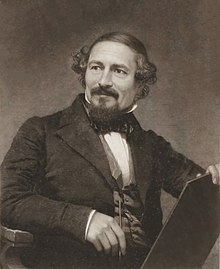John Sartain
| John Sartain | |
|---|---|
 |
|
| Born |
October 24, 1808 London, England |
| Died | October 25, 1897 (aged 89) Philadelphia, Pennsylvania |
| Nationality | British, American |
| Signature | |
John Sartain (October 24, 1808 – October 25, 1897) was an artist who pioneered mezzotint engraving in the United States.
John Sartain was born in London, England. He learned line engraving, and produced several of the plates in William Young Ottley's Early Florentine School (1826). In 1828, he began to make mezzotints. He studied painting under John Varley and Henry James Richter.
In 1830, at the age of 22, he emigrated to the United States and settled in Philadelphia. There he studied with Joshua Shaw and Manuel J. de Franca. For about ten years after his arrival in the United States, he painted portraits in oil and miniatures on ivory. During the same time, he found employment in making designs for banknote vignettes, and also in drawing on wood for book illustrations. He was a 33 degree Mason. He pioneered mezzotint engraving in the United States. He engraved plates in 1841–48 for Graham's Magazine, published by George Rex Graham, and believed his work was responsible for the publication's sudden success. Sartain became editor and proprietor of Campbell's Foreign Semi-Monthly Magazine in 1843. He had an interest at the same time in the Eclectic Museum, for which, later, when John H. Agnew was alone in charge, he simply engraved the plates.
John Sartain, Mary, Queen of Scots, The Evening Before Her Execution
John Sartain, Zachary Taylor
In 1848, he purchased a half interest in the Union Magazine, a New York City periodical. He transferred it to Philadelphia, where it was renamed Sartain's Union Magazine, and from 1849–52 he published it with Graham. It became very well known during those four years.
During this time, besides his editorial work and the engravings that had to be made regularly for the periodicals with which he was connected, Sartain produced an enormous quantity of plates for book illustrations.
...
Wikipedia
